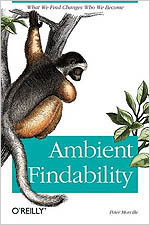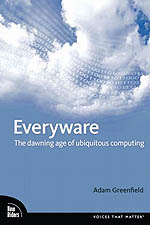Three great new books, all of which came out within the last month or so, were hot topics at SXSW 2006. What’s especially exciting to me is that all three of them are about subjects I am deeply interested in, and all of them are written by people I know and respect.
I’m reading all three of them pretty much in parallel right now (in addition to plowing through the final chapters of Don Quixote), so here’s a little (p)review of each of them.

Ambient Findability
This is Peter Morville‘s first solo effort, and it’s a trip. Peter, with Lou Rosenfeld, is the co-author of O’Reilley’s Information Architecture for the World Wide Web… aka, “the Polar Bear Book”. Peter is an outspoken advocate of “findability”, or the ability of a system to help people find what they’re looking for.
“Ambient” findability is Peter’s way of envisioning a future world (or perhaps describing the current world) in which information is findable — in theory — by anyone, anytime, anywhere. Ambient Findability the book is a sweeping portrait of findability in all its forms: he goes deep into findability on the web and the mobile space, but he also examines how findability has functioned for humanity historically and even biologically.
This new O’Reilly book, already being called “the Lemur Book”, is the first O’Reilly animal book that I have seen printed in full color, both on the cover and internally. It’s jam-packed with interesting material, but still short enough to finish on a plane trip or a weekend (or in my case 5 or 6 subway rides).

Everyware: The Dawning Age of Ubiquitous Computing
Adam Greenfield‘s Everyware, like Ambient Findability, covers a lot of ground, but in Everyware‘s case within the seemingly narrow topic of ubiquitous computing, the not-so-theoretical idea that in the future computers will be embedded into our physical spaces so deeply and thoroughly that meatspace and cyberspace will in many ways become indistinguishable.
I’ll just say up front that I think Adam Greenfield is a genius (and, apparently, a ninja). He’s managed to write a technology book woven out of a dozen diverse themes, including futurism, science fiction, culture, art, humanism, and even ethics. The book goes beyond simple technophilia vs. technophobia, and should be a required read for any person interested in even one of the above themes. I don’t think it’s hyperbolic to predict that some of what Adam says in Everyware will be cited and quoted by future thinkers for many years to come as we continue to deal with the ramifications of ubicomp.
In addition to being a scintillating writer (his blog, v-2.org, is fantastic), Adam is a compelling conversationalist and speaker, as well: I had the pleasure of chatting with Adam 3 times at SXSW, and his one-man “panel” presentation of the Everyware concept was riveting and deeply thought-provoking for everyone in the audience.

Getting Real
37signals has been evangelizing the concept of “getting real” for several years now, at conferences, at workshops and on their blog. Finally, they’ve compiled their thoughts into a digital book, downloadable from their web site. Getting Real was also a large part of 37signals’ Jason Fried and Coudal Partners‘ Jim Coudal’s keynote address at SXSW.
“Getting Real” simply means that a company should examine every one of their supposedly standard ways of doing things and consider whether or not they are really necessary at all. Everything from creating a detailed functional spec to holding team meetings is called into question. It’s project management minimalism, a direct extension of the minimalism espoused by many interface designers, including 37signals.
Whether on the blog or at a conference, the “getting real” concept generates a lot of heated discussion. I also have some strong opinions about many of the “getting real” ideas, both pro and con. But I ultimately think the book is a useful read, even if you don’t actually put any of their advice into practice. We all waste time and energy doing unnecessary work and building unnecessary features just to please a boss, a client, or an imagined customer need. Having a philosphy that allows a team to step back for a second to make sure they’re focusing on the real problems can only help.
The trick, for me, to reading this book is simple: You have to understand where it came from. A few years ago, 37signals transformed from a client-focused web design shop into an independent software developer. They’ve been steadily documenting their insights and opinions about this profound business metamorphosis, focusing particularly on how their ability to product high-quality products has improved dramatically once they were able to control their own process. Their enthusiasm, some would say smug glee, at this liberation is palpable in everything they do. But if you can get over that obstacle and look for tips that apply to your practice, there’s a lot to glean. For example at Behavior we take much of Getting Real with a big grain of salt: As a web development shop with diverse clients with genuine service needs, a lot of Getting Real is too lean and too mean. But for internal projects, smaller and more intimate clients, and ad hoc situations where nimble thinking is required to get past problems, Getting Real has a lot to offer.
Comments
2 responses to “SXSW Confidential, Part 2: They Write Books”
Dude, thinks for the reading tips! I’m in SF now, will stop by a bookstore. Just finished Wisdom of Crowds. (two years late)
Hey Steve! Yes, this SXSW reading list is hardly comprehensive. James Suroweicki’s The Wisdom of Crowds and Daniel Gilbert’s Stumbling on Happiness were some pretty hottt non-technology books, too (I even got a free copy of the latter, and I intend to read it as soon as I can!).